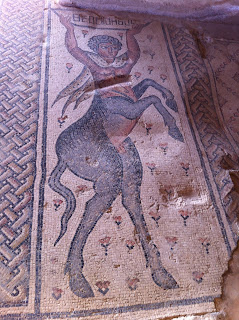Last day – one that
would include Armageddon!
But before we begin, remember the
first day, when I talked about Abu Ghosh? This is the site of the Road to
Emmaus and also where David danced before the Lord. We now have the video up
for that. It is beautiful. It’s here:
Also, more of the videos from the
trip are now, finally, getting posted, at:
http://www.youtube.com/imot2013 Click on Browse
videos to see the list.
Back to Day 9:
Omer Eshel, our kind host and the
Israeli Consul in Chicago, grew up in the Jezreel
Valley of Israel. This is north of Jerusalem and just a little west and
south of the Sea of Galilee. He was a farmer there.
 Open up your Bible and read 1
Samuel 31. This valley is where it took place. The Philistines were camped over
to the west where the white houses are now. Saul and his men were straight
ahead, in this view. He was outnumbered perhaps 20 to 1, so he consulted the witch
of Endor. Really bad idea.
Open up your Bible and read 1
Samuel 31. This valley is where it took place. The Philistines were camped over
to the west where the white houses are now. Saul and his men were straight
ahead, in this view. He was outnumbered perhaps 20 to 1, so he consulted the witch
of Endor. Really bad idea.
Endor is a small town, also in
this valley straight ahead. You can read about this in 1 Samuel 28.
When Saul learned he was going to
die, he fled to Mount Gilboa, in the same valley, to the east (right). It
should be called “Hill” Gilboa, because it isn’t really very high, though it is
steep. It’s the hill you can see just behind the two bushes. Here the
Philistines caught up with Saul, so he killed himself.
Also in this valley, off to the
left, is Tel Megiddo. There is a
high fortress there whose origins date back to 7000 BC. It is the place of
history’s first fully recorded battle, in 1479 BC, between Egypt’s King
Thutmose III and a group of Canaanite kings. Solomon built a fortified city
here (1 Kings 9:15), and countless battles were fought here over thousands of
years, including even Napoleon. Parts of the many layers of fortress remain.
The gate into the city shows partly how defended it was.
The
small rooms to each side of the entrance could hold soldiers who would attack
invaders. A drawing of the city gate shows a section of the entrance.

You can see how far above the
valley this fortress-city was. The highway you see down below has been the main
route through this part of Israel for thousands of years.
One of the features of this walled
city was its storage facilities.
Chief among them is its grain silo.
You can see that there was a downward path around the edge of the silo, so
someone could walk down inside to either store or retrieve grain. There
were actually two of these staircases, one on either side of the silo, so many
people could head down, collect grain, and head back up the other side, without
getting in each other’s way.
It is also where the Bible describes
the final battle between good and evil. Tel Megiddo has been mispronounced and
is in Revelation as “Armageddon” (Revelation 16:16).
Finally we went to Caesarea Maritima, a city that Herod
the Great built on the Mediterranean, between 25 and 13 BC, both as a retreat (like
another he built in Masada) and also to give Israel a port. The scale is
unbelievably massive. There is a huge amphitheater there that is reminiscent of
large outdoor theaters today. Even the entrances are huge.
The amphitheater itself can seat
10,000, and is used again today for big concerts.
Further down along the
coast is a huge swimming pool, which originally had inlaid mosaic floors all
around.
For many years, those who doubted
the Bible accounts also denied that anyone named Pontius Pilate ever existed.
They said there was no record of him in Roman history, and therefore he was a
Christian fiction. But in Caesarea, archeologists found a stone there
inscribed, “Pontius Pilate, the prefect of Judaea, erected a building dedicated
to the emperor Tiberius.” Bible wins again!
 There was also a huge race track
for chariot races. There were also countless buildings surrounding the
city as stores, warehouses and homes. The scale on all of this was massive, and
the finish on it quite refined and beautiful.
There was also a huge race track
for chariot races. There were also countless buildings surrounding the
city as stores, warehouses and homes. The scale on all of this was massive, and
the finish on it quite refined and beautiful.
They had all of the modern
conveniences, though this one was the
most surprising.
Finally we took one last picture
of all of us together on this grand tour. It was a delight and I made lifelong
friends. You will too!
Best of all, I got to see my Bible
come to life! I’m still HAPPY from the trip.
Start planning your pilgrimage
now. We’ll all go together.
-Pastor George
















































